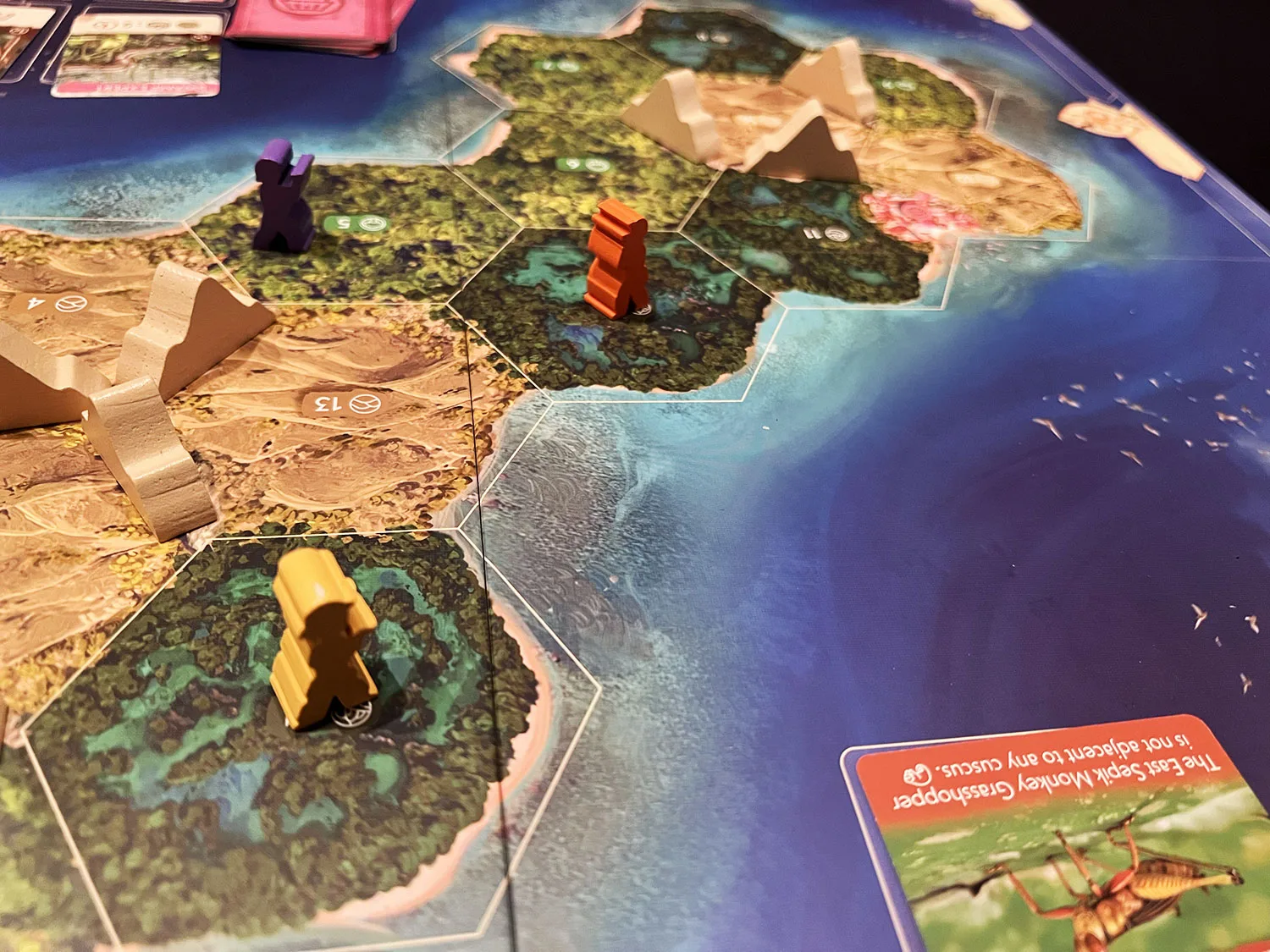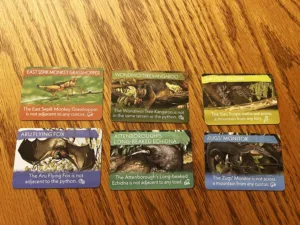 The Search for Planet X, designed by Ben Rosset and Matthew O’Malley, was released in 2020. It is a deduction game in which players try to logically determine where Planet X is located in our solar system. An app is used to reveal facts to each player based on their actions. Logic rules assist in determining the layout of the solar system, like a Dwarf Planet is NOT adjacent to Planet X. Basically, it is gamified Sudoku. Planet X was well received and garnered several Game of the Year nominations.
The Search for Planet X, designed by Ben Rosset and Matthew O’Malley, was released in 2020. It is a deduction game in which players try to logically determine where Planet X is located in our solar system. An app is used to reveal facts to each player based on their actions. Logic rules assist in determining the layout of the solar system, like a Dwarf Planet is NOT adjacent to Planet X. Basically, it is gamified Sudoku. Planet X was well received and garnered several Game of the Year nominations.
Fast forward to 2023. Ben and Matthew published a follow up to The Search to Planet X titled The Search for Lost Species. It is built on the same logic puzzle as Planet X; however, it adds more variety to the game. It included a board for players to move around (Planet X had a rotating horizon). Cards with in-game benefits or end game scoring bonuses were added. Finally, there are six different Lost Species to search for, each with a unique logic rule.
Does Lost Species steal the spotlight from its older sibling, or is Planet X still the better version? Continue reading to find out my thoughts.
Gameplay Overview:
The Search for Lost Species is made up of an undetermined number of turns, with each turn consisting of the active player (the player farthest back on the Time Track) preforming the following three steps:

1. Take one of five actions: Options include moving around the board on foot or by boat and searching for animals. Placing a camera trap that will tell you what, if any, animals are in that space. Visiting a town to draw a Town card and research a topic, or locating the lost species itself (IE: win the game).
2. Advance your pawn on the Time Track based on the number of spaces required for the action you selected
3. If the Expedition Leader (an NPC token) is farthest back on the Time Track, it is Activated and moved to the next Expedition Leader Space – this will trigger multiple potential activities ranging from allowing players to Report Sightings, to learning another logic rule applicable to the game.
Once the Lost Species is successfully spotted, the end game is triggered. All of the non-spotting players that are behind on the Time Track will have one more opportunity to score points, by either also Locating the Lost Species or Report Sightings. Once this is completed, final scores are tallied and the scientist with the most points wins!

Game Experience:
What made me want to search for a Lost Species?
I love the Sudoku-like puzzle this game presents. All the logic rules, either predetermined or discovered through gameplay, can be noted on a sheet that is hidden behind your player screen. As a bonus, the game rules are printed on your player screen, so time spent referring back to the rulebook is minimized. When you find the Python, you can immediately note that there are no Cuscus in any hex adjacent to the Python. Was a Toad sighting just revealed? Great, you know that Toads are adjacent to two empty areas. It is solving this puzzle, and where the Lost Species is, that is the heart of the game. And this puzzle is a blast to solve!
The app integration in this game is top-tier. If you have a friend who HATES app integration in their board games, this game MIGHT change their mind.
- First, the app is free.
- Second, it is SO user-friendly …well, except for “other” Brian. He is technologically challenged. But even he understood it after we walked him through a turn.
- Third, the game would not be anywhere near as elegant without the app. It generates a code that you share with your friends. Now all of you have the same logic rules. Boom. Start the game. Selecting your actions is easy. The game will tell you, and only you, the results of your actions and manages the rules, and responses, behind the scenes. I cannot picture playing this game without the app.

The Time Track, while not unique to “The Search for” series, is also implemented well. You know that the last token is the next active player. You know how many spaces you will move based on the action you choose. If you separate yourself too much from the pack, you may have to wait several turns before you get to go again; however, you may decide it is worth forging ahead to get the information you need (for example, placing a camera trap, which tells you exactly what animal, if any, is in your space).
Why would you forge ahead? The Expedition Leader may be moving to its next space, which is to retrieve your Camera Trap. This would allow you to place two Camera Traps in two turns. Balancing when to move forward vs. when to hold back is a key strategy that must be balanced throughout the game. The Expedition Leader moving also triggers the Reveal Sightings action on several of its moves. This is where players will place tokens upside down for a space in which they know (or THINK they know) an animal is located. In a later turn, the Expedition Leader will flip the tokens and the app will determine if the sighting was accurate or not. Either way, information is now shared between the table and, if accurate, scores the player points for their sighting.
What made me want to Search for Planet X
To be blunt, the original is more fun.

First, some of the new logic rules needlessly complicate an already successful formula. Look at that rulebook picture. That is just when directions are used. There are other new rules, such as animal totals vs. animal types, or animals not being adjacent if separated by a mountain, unless they are lorries. I THOUGHT I wanted a more complicated puzzle – it ended up I did not.
I was also excited about the inclusion of six unique Lost Species; however, my excitement waned when I discovered that the difference between each Lost Species is simply its unique Logic Rule. I do not know what I thought would vary between species, but I thought it would be more than a logic rule.

Finally, I THOUGHT moving around the board would be fun. It was, some of the time. But needing to worry about terrain types for some of the logic, as well as where you are in the board in relation to the areas you have deuced could sometimes be frustrating (for example, a sighting is revealed and now you know everything you need at the South end of the island—now you need to move North to figure out the rest of the puzzle).
Final Thoughts:
I enjoyed The Search for Lost Species. It is a fun logic puzzle to explore. The new card powers were a welcome addition. The new board adds a tangible exploration element to the formula.
If The Search for Planet X did not exist, this game would stay in my collection; unfortunately, I prefer the original more than this iteration. It is more elegant. The new logic rules needlessly complicate the game. Moving around the board can be more of a chore than exciting.
Sometimes less is more. That certainly applies in this case.
Final Score: 3 Stars – A good game that does not improve on the original’s formula.
 Hits:
Hits:
• Another fun logic puzzle
• Excellent app integration
• Use of the Time Track and driving action selection
• Inclusion of cards and their bonuses/scoring opportunities
Misses:
• Additional layers of logic rules are needlessly complicated
• Multiple Lost Species not impactful
• Moving around the board is not as fun as it sounds






















